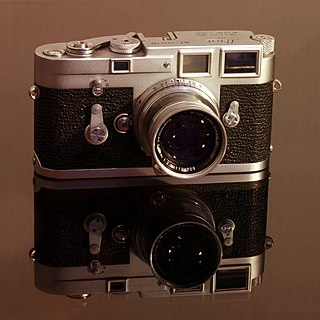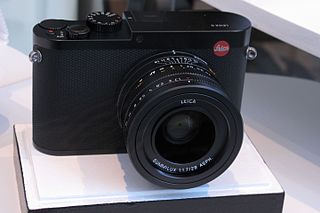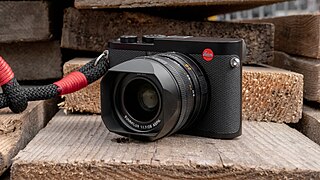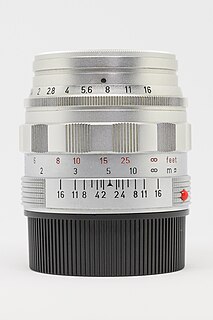
Leica Camera AG is a German company that manufactures cameras, lenses, binoculars, rifle scopes, microscopes and ophthalmic lenses. The company was founded by Ernst Leitz in 1869, in Wetzlar, Germany.

Macro photography is extreme close-up photography, usually of very small subjects and living organisms like insects, in which the size of the subject in the photograph is greater than life size . By the original definition, a macro photograph is one in which the size of the subject on the negative or image sensor is life size or greater. In some senses, however, it refers to a finished photograph of a subject that is greater than life size.

The Leica M3 is a 35 mm rangefinder camera by Ernst Leitz GmbH, introduced in 1954. It was a new starting point for Leitz, which until then had only produced screw-mount Leica cameras that were incremental improvements to its original Leica (Ur-Leica). The M3 introduced several features to the Leica, among them the combination of viewfinder and rangefinder in one bright window, like on the Contax II, a bayonet lens mount, and rapid film advance lever. It was the most successful model of the M series, with over 220,000 units sold by the time production of the M3 model ended in 1966.

The Leica M8 is the first digital camera in the rangefinder M series introduced by Leica Camera AG on 14 September 2006. It uses an APS-H 10.3-megapixel Kodak KAF-10500 CCD image sensor.
Walter Mandler was a lens designer of Ernst Leitz Canada in Midland, Ontario. Mandler is credited with the design of more than 45 Leica lenses for the Leica rangefinder cameras and Leica SLR cameras.

The name Noctilux is used by Leica to designate camera lenses that have a maximum aperture of f/0.95. This is the largest f-number offered by Leica in its lens range. The lens has been in production since 1966 and carries on to the present day. So far all Noctilux lenses have been made for the Leica M mount.

The Leica M mount is a camera lens mount introduced in 1954 with the Leica M3, and a range of lenses. It has been used on all the Leica M-series cameras and certain accessories up to the current film Leica M-A and digital Leica M10 cameras.

The Leica CL is a 35mm compact rangefinder camera with interchangeable lenses in the Leica M-mount. It was developed in collaboration with Minolta who manufactured it. It first appeared in April 1973 and was released in the Japanese market in November 1973 as the Leitz Minolta CL. Both the Leica CL and Leitz Minolta CL were manufactured in a new Minolta factory in Osaka. In 2017, Leica announced a new digital mirrorless camera, again named Leica CL.

The name Elmarit is used by Leica to designate camera lenses that have a maximum aperture of f/2.8.
Cosina Voigtländer refers to photographic products manufactured by Cosina under the Voigtländer name since 1999. Cosina leases rights to the Voigtländer name from RINGFOTO GmbH & Co. ALFO Marketing KG in Germany. Cosina Voigtländer products have included 35mm film SLR and rangefinder camera bodies, and lenses for the M39 lens mount, M42 lens mount, Leica M mount, and other lens mounts.

The Leica Q is a full-frame fixed-lens camera announced by Leica on June 10, 2015. The Leica Q2 was announced in March 2019.

The Leica SL is a full-frame mirrorless interchangeable-lens camera announced by Leica Camera AG on 20 October 2015. The SL is promoted as a camera system for professional applications. Beside the Leica S-System, the Leica SL-System is the 2nd professional camera system in the company's product portfolio.
The Leica Vario-Elmarit-SL 24-90mm F2.8-4 ASPH is an interchangeable standard zoom lens for Leica L mount, announced by Leica on October 20, 2015.
The Panasonic Leica D Vario-Elmarit 14-50mm F2.8-3.5 ASPH Mega OIS is an interchangeable camera lens announced by Panasonic on February 26, 2006. It was the first Leica lens with optical image stabilisation.

The Leica L-Mount is a bayonet mount developed by Leica Camera AG for interchangeable-lens autofocus digital cameras.

The Leica Q2 is a full-frame fixed-lens camera.

The name Summilux is used by Leica and Panasonic Lumix to designate camera lenses that have a maximum aperture of f/1.4. The lens has been in production since 1959 and carries on to the present day.

The name Summarit is used by Leica to designate camera lenses that have a maximum aperture of f/2.4. The name has been in used since 1949.

The name Elmar is used by Leica to designate camera lenses of four elements that have a maximum aperture of f/3.98 or f/4.0.
The Leica S-System is a medium format digital single lens reflect camera system introduced by Leica Camera in 1996. Beginning with the Leica S1, a prototype top-end studio digital camera unveiled at Photokina 1996. It went into production at the end of 1997.


















